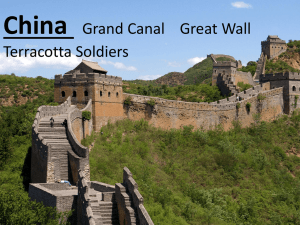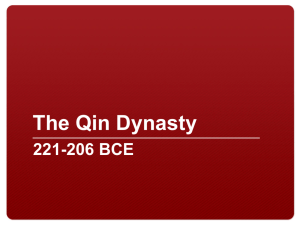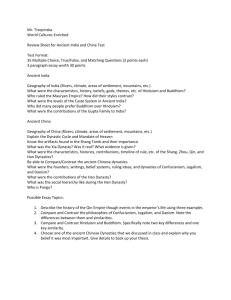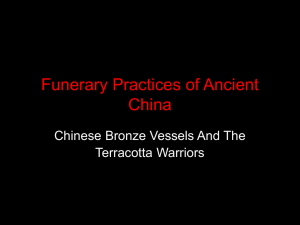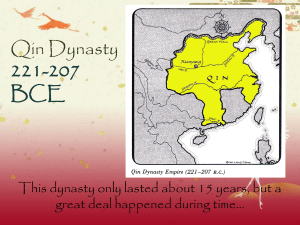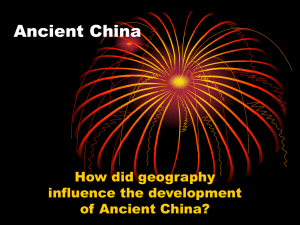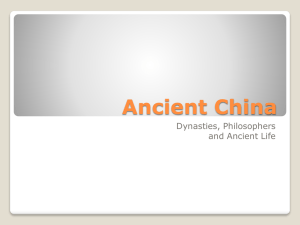Word Format - WACE 2015 2016
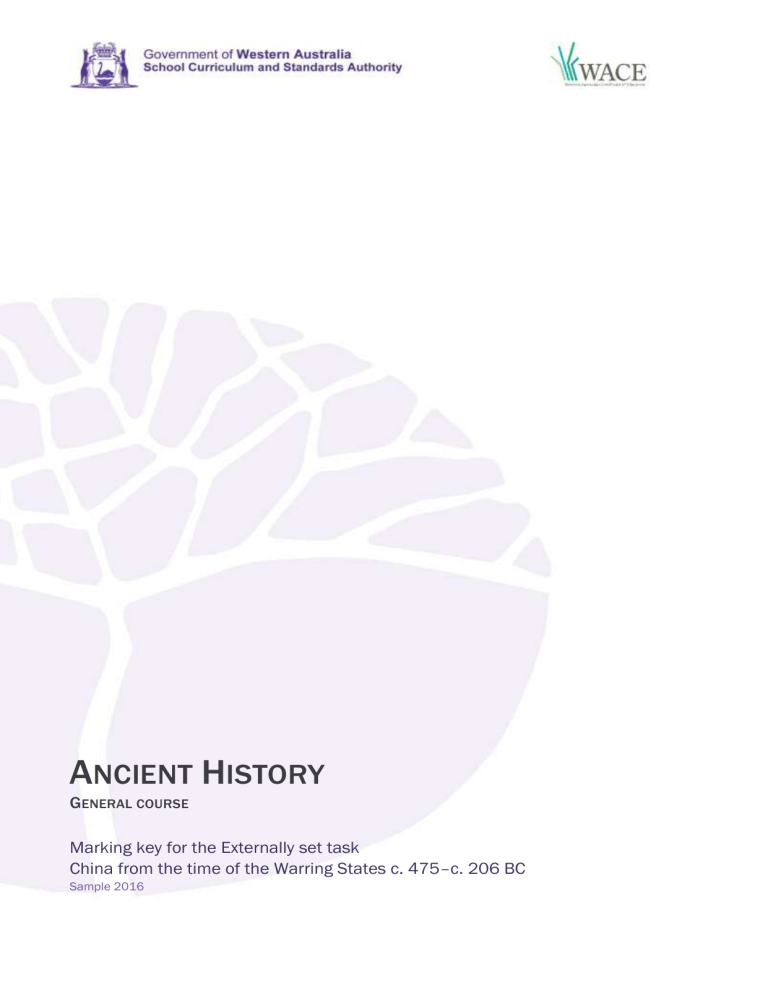
G
A
NCIENT
ENERAL COURSE
H
ISTORY
Marking key for the Externally set task
China from the time of the Warring States c. 475–c. 206 BC
Sample 2016
Copyright
© School Curriculum and Standards Authority, 2014
This document – apart from any third party copyright material contained in it – may be freely copied, or communicated on an intranet, for non-commercial purposes in educational institutions, provided that the School Curriculum and Standards Authority is acknowledged as the copyright owner, and that the Authority’s moral rights are not infringed.
Copying or communication for any other purpose can be done only within the terms of the Copyright Act 1968 or with prior written permission of the School Curriculum and Standards Authority. Copying or communication of any third party copyright material can be done only within the terms of the Copyright Act 1968 or with permission of the copyright owners.
Any content in this document that has been derived from the Australian Curriculum may be used under the terms of the Creative Commons
Attribution-NonCommercial 3.0 Australia licence
Disclaimer
Any resources such as texts, websites and so on that may be referred to in this document are provided as examples of resources that teachers can use to support their learning programs. Their inclusion does not imply that they are mandatory or that they are the only resources relevant to the course.
2014/10145
1
Ancient History
Externally set task – marking key
NOTE – When marking a candidate’s work:
1. Not all points necessarily need to be in an answer for the candidate to gain full marks.
2. Reward each salient point made by the candidate. Candidates may make different valid points of interpretation.
3. Candidates are expected to refer to relevant supporting evidence from the sources.
1.
Tick one (1) of the following in (a) and (b) to best describe Source 1.
(a) ancient source modern source
(2 marks)
(b) written source archaeological source map/diagram reconstruction
Ancient History | General | Externally set task| Marking key | China c. 475–c. 206 BC | Sample 2016
2
2.
Identify and briefly discuss the historical context for Source 1. You should consider the following where appropriate:
the relevant event/s
the significant person/people
the key idea/s depicted in the source. (4 marks)
Marks Description
Accurately identifies and briefly discusses the historical context of Source 1, demonstrating a sound historical knowledge of the period.
The answer includes discussion of:
relevant event/s and/or
significant person/people and/or
key idea/s.
4
Identifies and briefly discusses the historical context of Source 1, demonstrating some historical knowledge of the period, but with omissions.
The answer includes some discussion of:
relevant event/s and/or
significant person/people and/or
key idea/s.
Identifies and provides a simple description of the historical context, demonstrating a limited historical knowledge of the period.
The answer includes a limited description of the:
relevant event/s and/or
significant person/people and/or
key idea/s.
The answer demonstrates little historical knowledge of the period, with very simple description of:
one (or two) of the criteria mentioned above, or
or the answer is factually inaccurate, or
or the answer simply describes the source.
Total
Answer could include, but is not limited to:
3
2
1
4
Key ideas
This is a photograph of the Great Wall which was built primarily for defence of the northern borders of China against nomads and any other potential invaders. The Great Wall was also useful for controlling trade along the Silk Road and immigration.
Events and significant people
Some walls were built as early as the 7th century BC. Over the centuries, the walls were joined and strengthened. More walls were built during the Warring States period by the individual kingdoms.
Qin Shi Huang conquered the independent states to unite China and destroyed their walls. He created a new border with the part of the wall he had built between 220 and 206 BC, which is the most famous part of what became the Great Wall. Very little of this part of the Wall remains.
Other points provided by the students should be judged on their merits.
Ancient History | General | Externally set task | Marking key | China c. 475–c. 206 BC | Sample 2016
3
3.
Identify and explain the message/s of Source 2. Provide evidence in your response.
Description
Accurately identifies and clearly explains the message/s of Source 2. Provides clear evidence to support the answer.
Identifies and briefly explains the message/s of Source 2. Provides limited evidence to support the answer.
Identifies and describes a message of Source 2, with little explanation and/or evidence provided.
(4 marks)
Marks
4
3
2
The answer reflects little understanding of Source 2, with a simple recount of the contents of the source.
Total
1
4
Answer could include, but is not limited to:
Qin Shi Huang (formerly King Zen of Qin) unified China by conquering the other Warring States. He became the Emperor. Li Si, the Qin Dynasty Prime Minister, assisted Qin Shi Huang with the unification of China.
The message of Source 2 is that the Emperor and his Prime Minister unified China through economic and communication reforms. All measurements and weights were standardised, even the ‘axles of the carts’ to aid transport. The currencies of the different states were standardised to the ‘Ban liang coin’. A very important reform was the unification of the Chinese script by the standardising of the ‘seal script of the state of Qin’, which was ‘made official throughout all the conquered regions’. This replaced many regional scripts with one language. This was a great improvement to communication throughout China. An underlying message is that the conquered states had to accept the changes ordered by the Emperor.
Other points provided by the students should be judged on their merits.
Ancient History | General | Externally set task| Marking key | China c. 475–c. 206 BC | Sample 2016
4
4.
Outline and briefly explain the major changes occurring in the society which are depicted in Source 1 and Source 2. Provide evidence in your response. (6 marks)
Description Marks
Accurately outlines one major change depicted in Source 1 and one major change depicted in Source 2.
Clearly explains both changes.
Supports answer with evidence from each source.
6
Accurately outlines one major change depicted in Source 1 and one major change depicted in Source 2.
Explains both changes.
Attempts to support answer with limited evidence from the sources.
Accurately outlines one major change depicted in one of the sources. Clearly explains the change. Supports answer with evidence from the source.
AND
Outlines one major change depicted in the other source. Provides some explanation of the change or limited evidence from the source.
5
4
Outlines one major change depicted in one of the sources. Provides some explanation of the change and some evidence from the source.
AND
Outlines one major change depicted in the other source with inaccuracies in the explanation or little supporting evidence for the other source.
3
Identifies one major change depicted in Source 1 and one major change in
Source 2 with inaccuracies in the explanation or without evidence from the two sources.
Identifies one change depicted in either source with inaccuracies or without evidence.
Total
2
1
6
Answer could include, but is not limited to:
Source 1 (the photograph of the Great Wall) represents early attempts by the separate kingdoms and states in China to protect their own northern borders. A major change was the Warring States period, which came after the Spring and Autumn Period, a time of relative peace. During the
Warring States period, there were many conflicts and all seven states built their own walls for protection of their kingdoms against each other.
Another major change depicted in Source 1 occurred when Qin Shi Huang’s Qin state conquered the other states to create a unified China. He destroyed the earlier walls and created a new border for his Empire, which later became the Great Wall. This would have served as a reminder of his power over the once independent territories
Source 2 depicts some of the changes that Qin Shi Huang and Li Si introduced to the new empire, such as the standardising of measurements, weights, currencies and even the language, to reinforce his control over all of China. China had been made up of a number of independent states with their own rulers or kings, but now it was to be ruled by one set of laws and one Emperor. The economic and communication reforms helped to create a unified China.
Other points provided by the students should be judged on their merits.
Ancient History | General | Externally set task | Marking key | China c. 475–c. 206 BC | Sample 2016
5
5.
Discuss ‘change’ in this ancient society.
In developing your response, you should:
use the changes shown in both sources as your starting point
identify and explain other major changes that occurred in the society
illustrate the importance of the changes.
Description
Changes depicted in sources
Presents a summary of the changes in the ancient society that are depicted in the
two sources
States some of the changes in the ancient society that are depicted in at least
one of the sources
Identification and explanation of other major changes that occurred in the ancient society
Marks
2
2
1
4
(9 marks)
Accurate identification and clear explanation of some of the other major changes that occurred in the ancient society
Accurate identification with limited explanation of a few of the other major changes that occurred in the ancient society
Lists some of the other major changes that occurred in the ancient society
Lists one or two of the major changes that occurred in the ancient society with inaccuracies
Illustration of the importance of the changes
4
3
2
1
3
Illustrates the importance of the changes that occurred in the ancient society with some explanation and provision of evidence or examples
Attempts to illustrate the importance of the changes that occurred in the ancient society with limited explanation and little provision of evidence or examples
States the importance of a change/s with little to no explanation or provision of examples
Total
3
2
1
9
Context specific points
This question invites the student to write what they know about change during the whole period of study.
Note:
Responses should consider the particular changes that are shown in the sources.
The responses should then consider the other major changes that have occurred in the society they are studying. These changes may be military, political, social, cultural, religious, economic and/or leadership.
The response then needs to consider the importance of the changes.
The specific points made in the responses will depend on what has been taught in the classroom.
Ancient History | General | Externally set task| Marking key | China c. 475–c. 206 BC | Sample 2016
6
Other major changes in the period include:
the Warring States period brought in a time of great conflict between the seven major states and their tributaries. This began with the partition of Jin into three states: the Han, Zhao and Wei. This partition allowed the other four major states to expand their own territories. The alliance of the three states (Han, Zhao and Wei) is broken when Wei became too strong. The other states became involved in the conflict and many wars occurred during the Warring States period. At different times, the Qin, the Qi, the Zhao, and the Chu were victorious in these wars. Eventually the Qin conquer all the other states and Qin Shi Huang became the First Emperor
changes to warfare: much of the warfare conducted before the Warring States period was by nobles in chariots. The Warring States period saw the introduction of massed infantry of peasant soldiers and possibly crossbows. This led to a decline in the importance and power of the nobility and a growth in power of the kings. These changes were accompanied by the introduction of iron for weaponry and armour and the use of cavalry. The increased numbers led to a great increase in the scale of warfare
development of military strategy: several of the Seven Military Classics were written during this time
associated with these changes to warfare was the development of the new bureaucracies that were needed to organise and supply the very large armies. These bureaucracies were able to organise a number of very large-scale projects; for example, irrigation works
there was economic development through the growth of iron-working, and trade due to the establishment of the larger states
there was a development of many philosophical doctrines during the Warring States period, which was known as the Hundred Schools of Thought, and Confucianism was very influential. But this changed in the Qin period to one philosophy. Legalism and all others were suppressed. From
213 to 210 BC, books were burned and Confucian scholars were killed
the Qin dynasty ended feudalism and brought in a hierarchical and centralised, but very efficient, bureaucracy that answered to the Emperor. Everything was standardised in the Empire, including language
the Qin dynasty ended with the start of civil wars
another major change of this period was the establishment of the Qin dynasty because it introduced enormous change to China through unification and centralisation of control.
Measurements, language, philosophy and government were all standardised and controlled through a set of laws which were applied throughout the country. Everyone was under the control of the Emperor for the first time
the changes to warfare were also significant because this led to the growth in power of a number of States and eventually to the rise of the Qin. The change to mass infantry led to the development of large bureaucracies that would be used to run the Empire.
Ancient History | General | Externally set task | Marking key | China c. 475–c. 206 BC | Sample 2016

